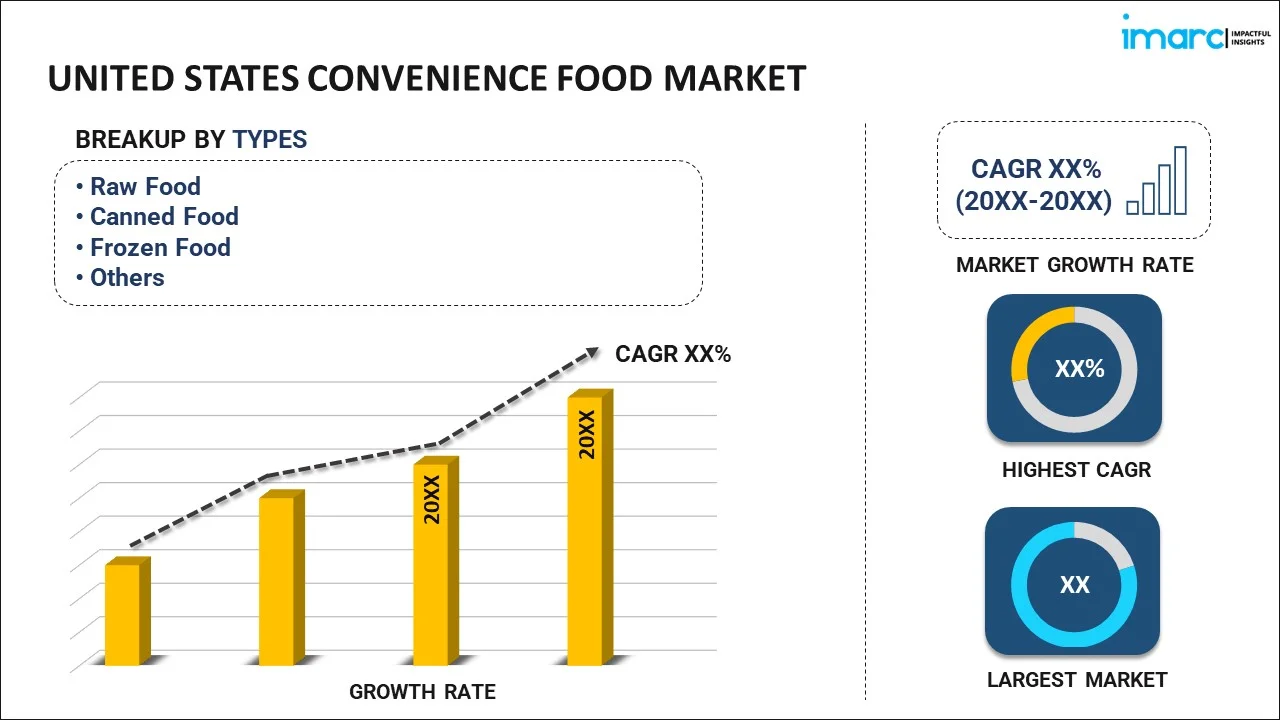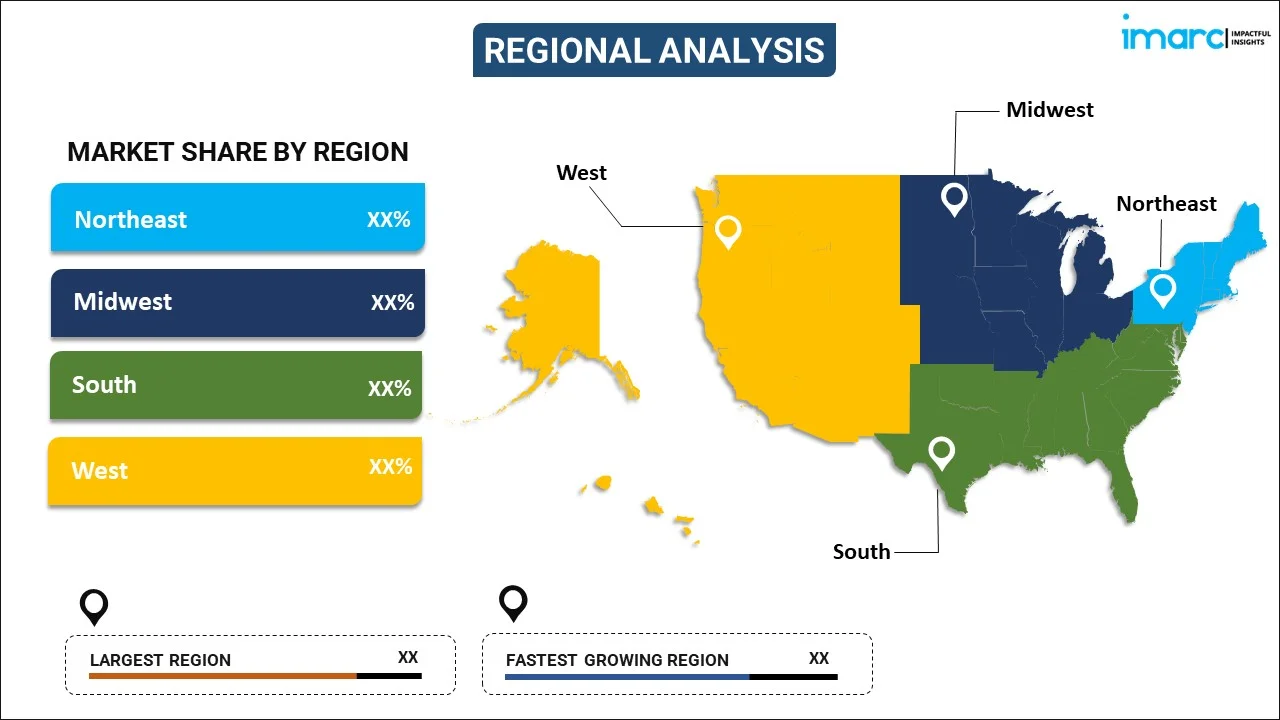
United States Convenience Food Market Report by Type (Raw Food, Canned Food, Frozen Food, Ready-To-Eat, Ready-To-Cook, and Others), Product (Meat/Poultry Products, Cereal-based Products, Vegetable-based Products, and Others), Distribution Channel (Supermarkets and Hypermarkets, Convenience Stores, Specialty Stores, and Others), and Region 2025-2033
Market Overview:
United States convenience food market size is projected to exhibit a growth rate (CAGR) of 3.33% during 2025-2033. The widespread adoption of pre-packaged and processed options that are tailored for quick and effortless preparation, resonating with those seeking instant gratification or lacking extensive cooking skills, is primarily augmenting the market growth.
|
Report Attribute
|
Key Statistics
|
|---|---|
|
Base Year
|
2024 |
|
Forecast Years
|
2025-2033 |
|
Historical Years
|
2019-2024
|
| Market Growth Rate (2025-2033) | 3.33% |
Convenience food refers to food products that are pre-packaged or processed, designed for quick and easy preparation with minimal time and effort. These items are crafted to serve as a convenient solution for individuals with busy lifestyles, limited cooking skills, or a preference for instant meals. The range of convenience foods is broad, encompassing items like ready-to-eat meals, frozen dinners, canned soups, instant noodles, microwaveable snacks, and pre-cut vegetables. To prolong shelf life and preserve quality, these foods typically undergo various processing stages, including cooking, freezing, drying, and packaging. While convenience foods offer the benefit of timesaving and simplicity, they often involve certain trade-offs. To enhance flavor and preservation, these products may contain higher levels of preservatives, additives, sodium, and sugar, which are considerations for those mindful of their dietary choices.
United States Convenience Food Market Trends:
The United States convenience food market stands as a dynamic and essential segment of the nation's food industry, catering to the needs of individuals with hectic lifestyles and time constraints. This market includes a wide range of choices, from ready-to-eat meals and frozen dinners to canned soups, instant noodles, microwaveable snacks, and pre-cut vegetables. Additionally, the U.S. convenience food market reflects the evolving demands of a fast-paced society, providing solutions for consumers juggling various responsibilities. Many of these products undergo processing stages, involving cooking, freezing, drying, and packaging to extend shelf life, which can result in higher levels of preservatives, additives, sodium, and sugar. This trade-off between convenience and nutritional content is a key consideration for consumers. As the market continues to adapt to changing preferences and health-conscious choices, there is a growing emphasis on offering healthier and more diverse convenience food options in the United States, balancing the need for quick meals with the desire for nutritional value. This, in turn, is anticipated to fuel the market growth across the country over the forecasted period.
United States Convenience Food Market Segmentation:
IMARC Group provides an analysis of the key trends in each segment of the market, along with forecasts at the country level for 2025-2033. Our report has categorized the market based on type, product, and distribution channel.
Type Insights:

- Raw Food
- Canned Food
- Frozen Food
- Ready-To-Eat
- Ready-To-Cook
- Others
The report has provided a detailed breakup and analysis of the market based on the type. This includes raw food, canned food, frozen food, ready-to-eat, ready-to-cook, and others.
Product Insights:
- Meat/Poultry Products
- Cereal-based Products
- Vegetable-based Products
- Others
A detailed breakup and analysis of the market based on the product have also been provided in the report. This includes meat/poultry products, cereal-based products, vegetable-based products, and others.
Distribution Channel Insights:
- Supermarkets and Hypermarkets
- Convenience Stores
- Specialty Stores
- Others
The report has provided a detailed breakup and analysis of the market based on the distribution channel. This includes supermarkets and hypermarkets, convenience stores, specialty stores, and others.
Regional Insights:

- Northeast
- Midwest
- South
- West
The report has also provided a comprehensive analysis of all the major regional markets, which include Northeast, Midwest, South, and West.
Competitive Landscape:
The market research report has also provided a comprehensive analysis of the competitive landscape. Competitive analysis such as market structure, key player positioning, top winning strategies, competitive dashboard, and company evaluation quadrant has been covered in the report. Also, detailed profiles of all major companies have been provided.
United States Convenience Food Market Report Coverage:
| Report Features | Details |
|---|---|
| Base Year of the Analysis | 2024 |
| Historical Period | 2019-2024 |
| Forecast Period | 2025-2033 |
| Units | Billion USD |
| Scope of the Report | Exploration of Historical Trends and Market Outlook, Industry Catalysts and Challenges, Segment-Wise Historical and Future Market Assessment:
|
| Types Covered | Raw Food, Canned Food, Frozen Food, Ready-To-Eat, Ready-To-Cook, Others |
| Products Covered | Meat/Poultry Products, Cereal-based Products, Vegetable-based Products, Others |
| Distribution Channels Covered | Supermarkets and Hypermarkets, Convenience Stores, Specialty Stores, Others |
| Regions Covered | Northeast, Midwest, South, West |
| Customization Scope | 10% Free Customization |
| Post-Sale Analyst Support | 10-12 Weeks |
| Delivery Format | PDF and Excel through Email (We can also provide the editable version of the report in PPT/Word format on special request) |
Key Questions Answered in This Report:
- How has the United States convenience food market performed so far and how will it perform in the coming years?
- What has been the impact of COVID-19 on the United States convenience food market?
- What is the breakup of the United States convenience food market on the basis of type?
- What is the breakup of the United States convenience food market on the basis of product?
- What is the breakup of the United States convenience food market on the basis of distribution channel?
- What are the various stages in the value chain of the United States convenience food market?
- What are the key driving factors and challenges in the United States convenience food?
- What is the structure of the United States convenience food market and who are the key players?
- What is the degree of competition in the United States convenience food market?
Key Benefits for Stakeholders:
- IMARC’s industry report offers a comprehensive quantitative analysis of various market segments, historical and current market trends, market forecasts, and dynamics of the United States convenience food market from 2019-2033.
- The research report provides the latest information on the market drivers, challenges, and opportunities in the United States convenience food market.
- Porter's five forces analysis assist stakeholders in assessing the impact of new entrants, competitive rivalry, supplier power, buyer power, and the threat of substitution. It helps stakeholders to analyze the level of competition within the United States convenience food industry and its attractiveness.
- Competitive landscape allows stakeholders to understand their competitive environment and provides an insight into the current positions of key players in the market.
Need more help?
- Speak to our experienced analysts for insights on the current market scenarios.
- Include additional segments and countries to customize the report as per your requirement.
- Gain an unparalleled competitive advantage in your domain by understanding how to utilize the report and positively impacting your operations and revenue.
- For further assistance, please connect with our analysts.
 Inquire Before Buying
Inquire Before Buying
 Speak to an Analyst
Speak to an Analyst
 Request Brochure
Request Brochure
 Request Customization
Request Customization




.webp)




.webp)












